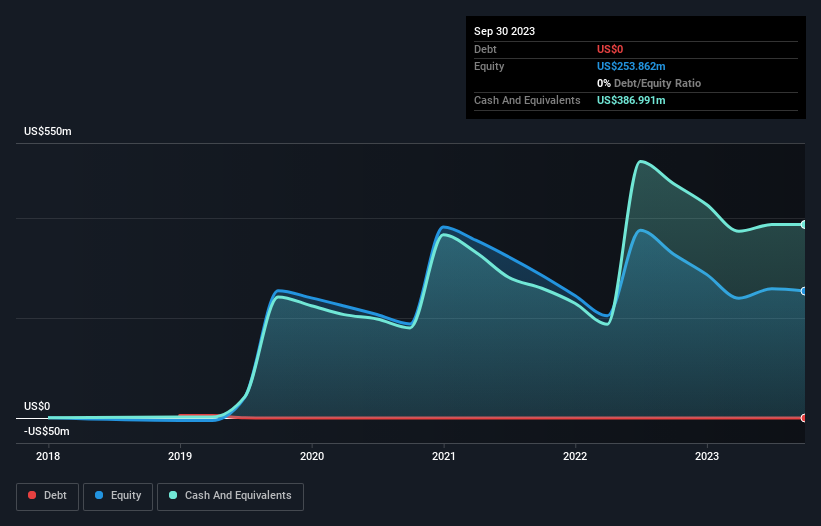- United States
- /
- Biotech
- /
- NasdaqGS:IGMS
We Think IGM Biosciences (NASDAQ:IGMS) Needs To Drive Business Growth Carefully

There's no doubt that money can be made by owning shares of unprofitable businesses. For example, although Amazon.com made losses for many years after listing, if you had bought and held the shares since 1999, you would have made a fortune. Having said that, unprofitable companies are risky because they could potentially burn through all their cash and become distressed.
So should IGM Biosciences (NASDAQ:IGMS) shareholders be worried about its cash burn? In this article, we define cash burn as its annual (negative) free cash flow, which is the amount of money a company spends each year to fund its growth. The first step is to compare its cash burn with its cash reserves, to give us its 'cash runway'.
See our latest analysis for IGM Biosciences
Does IGM Biosciences Have A Long Cash Runway?
A cash runway is defined as the length of time it would take a company to run out of money if it kept spending at its current rate of cash burn. In September 2023, IGM Biosciences had US$387m in cash, and was debt-free. Importantly, its cash burn was US$196m over the trailing twelve months. Therefore, from September 2023 it had 2.0 years of cash runway. While that cash runway isn't too concerning, sensible holders would be peering into the distance, and considering what happens if the company runs out of cash. You can see how its cash balance has changed over time in the image below.

How Is IGM Biosciences' Cash Burn Changing Over Time?
In our view, IGM Biosciences doesn't yet produce significant amounts of operating revenue, since it reported just US$1.9m in the last twelve months. Therefore, for the purposes of this analysis we'll focus on how the cash burn is tracking. Remarkably, it actually increased its cash burn by 1,457% in the last year. With that kind of spending growth its cash runway will shorten quickly, as it simultaneously uses its cash while increasing the burn rate. While the past is always worth studying, it is the future that matters most of all. So you might want to take a peek at how much the company is expected to grow in the next few years.
How Hard Would It Be For IGM Biosciences To Raise More Cash For Growth?
Given its cash burn trajectory, IGM Biosciences shareholders may wish to consider how easily it could raise more cash, despite its solid cash runway. Companies can raise capital through either debt or equity. Many companies end up issuing new shares to fund future growth. We can compare a company's cash burn to its market capitalisation to get a sense for how many new shares a company would have to issue to fund one year's operations.
IGM Biosciences' cash burn of US$196m is about 56% of its US$351m market capitalisation. That's high expenditure relative to the value of the entire company, so if it does have to issue shares to fund more growth, that could end up really hurting shareholders returns (through significant dilution).
How Risky Is IGM Biosciences' Cash Burn Situation?
On this analysis of IGM Biosciences' cash burn, we think its cash runway was reassuring, while its increasing cash burn has us a bit worried. Summing up, we think the IGM Biosciences' cash burn is a risk, based on the factors we mentioned in this article. An in-depth examination of risks revealed 4 warning signs for IGM Biosciences that readers should think about before committing capital to this stock.
Of course, you might find a fantastic investment by looking elsewhere. So take a peek at this free list of interesting companies, and this list of stocks growth stocks (according to analyst forecasts)
New: AI Stock Screener & Alerts
Our new AI Stock Screener scans the market every day to uncover opportunities.
• Dividend Powerhouses (3%+ Yield)
• Undervalued Small Caps with Insider Buying
• High growth Tech and AI Companies
Or build your own from over 50 metrics.
Have feedback on this article? Concerned about the content? Get in touch with us directly. Alternatively, email editorial-team (at) simplywallst.com.
This article by Simply Wall St is general in nature. We provide commentary based on historical data and analyst forecasts only using an unbiased methodology and our articles are not intended to be financial advice. It does not constitute a recommendation to buy or sell any stock, and does not take account of your objectives, or your financial situation. We aim to bring you long-term focused analysis driven by fundamental data. Note that our analysis may not factor in the latest price-sensitive company announcements or qualitative material. Simply Wall St has no position in any stocks mentioned.
About NasdaqGS:IGMS
IGM Biosciences
A biotechnology company, develops Immunoglobulin M antibodies for the treatment of cancer and autoimmune and inflammatory diseases.
Excellent balance sheet low.
Market Insights
Community Narratives



